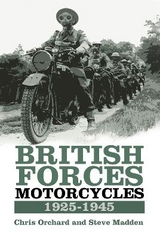
British Forces Motorcycles
1925-45
Seiten
2006
|
New edition
Sutton Publishing Ltd (Verlag)
978-0-7509-4451-9 (ISBN)
Sutton Publishing Ltd (Verlag)
978-0-7509-4451-9 (ISBN)
- Titel ist leider vergriffen;
keine Neuauflage - Artikel merken
Zu diesem Artikel existiert eine Nachauflage
After many centuries of use by the Army for patrols and communications, the trusty horse was finally supplanted by the new-fangled motorcycle. This mechanization process gathered pace during the interwar years and in particular for the military motorcycle between 1925 and 1939. This book looks at all military motorcycles of British origin.
Perhaps the most far reaching of the many changes wrought on the military by the First World War was the mechanization of the armed services. After many centuries of use by the Army for patrols and communications, the trusty horse was finally supplanted by the new-fangled motorcycle. This mechanization process gathered pace during the interwar years and in particular for the military motorcycle between 1925 and 1939. By the outbreak of the Second World War the motorcycle had become an important part of the military inventory and deemed 'suitable for WD (War Department) requirements'. When it was first published in 1995, this fully illustrated book was unique in looking at all military motorcycles of British origin known to have been tested mainly by the Mechanical Warfare Experimental Establishment (later called the Mechanisation Experimental Establishment). Ten years on, the authors are producing a fully revised and updated new edition of their book that will include three new chapters covering standard parts, bike markings and paint schemes. There will also be a picture spread that illustrates despatch rider's clothing.
New to this edition will be a 16pp colour section that will illustrate restored WD bikes, including detail shots of engines and components.
Perhaps the most far reaching of the many changes wrought on the military by the First World War was the mechanization of the armed services. After many centuries of use by the Army for patrols and communications, the trusty horse was finally supplanted by the new-fangled motorcycle. This mechanization process gathered pace during the interwar years and in particular for the military motorcycle between 1925 and 1939. By the outbreak of the Second World War the motorcycle had become an important part of the military inventory and deemed 'suitable for WD (War Department) requirements'. When it was first published in 1995, this fully illustrated book was unique in looking at all military motorcycles of British origin known to have been tested mainly by the Mechanical Warfare Experimental Establishment (later called the Mechanisation Experimental Establishment). Ten years on, the authors are producing a fully revised and updated new edition of their book that will include three new chapters covering standard parts, bike markings and paint schemes. There will also be a picture spread that illustrates despatch rider's clothing.
New to this edition will be a 16pp colour section that will illustrate restored WD bikes, including detail shots of engines and components.
Chris Orchard is works safety engineer for Cooper-Avon Tires. He has been involved in the classic bike scene for many years, as has his co-author Steve Madden who works as a specialist civil servant. Both Chris (who lives in Melksham) and Steve (who lives in Hampshire) own and restore former-WD motorcycles.
| Erscheint lt. Verlag | 21.9.2006 |
|---|---|
| Zusatzinfo | 140 black and white illustrations |
| Verlagsort | Stroud |
| Sprache | englisch |
| Maße | 172 x 244 mm |
| Gewicht | 800 g |
| Themenwelt | Natur / Technik ► Fahrzeuge / Flugzeuge / Schiffe ► Auto / Motorrad |
| Natur / Technik ► Fahrzeuge / Flugzeuge / Schiffe ► Militärfahrzeuge / -flugzeuge / -schiffe | |
| ISBN-10 | 0-7509-4451-X / 075094451X |
| ISBN-13 | 978-0-7509-4451-9 / 9780750944519 |
| Zustand | Neuware |
| Haben Sie eine Frage zum Produkt? |
Mehr entdecken
aus dem Bereich
aus dem Bereich



